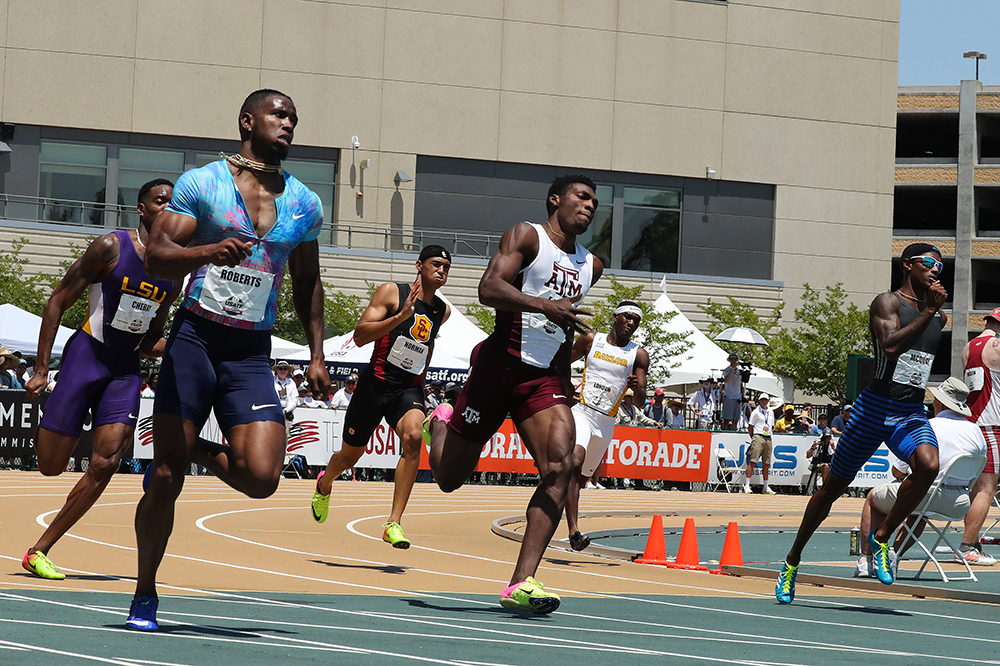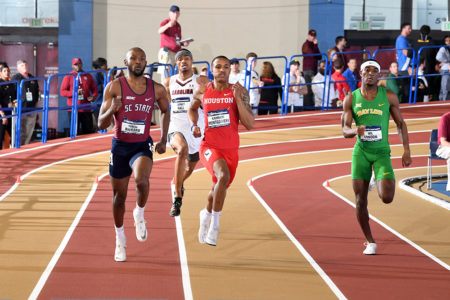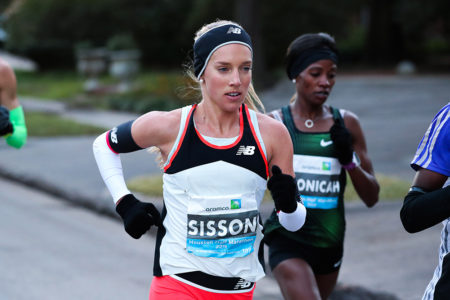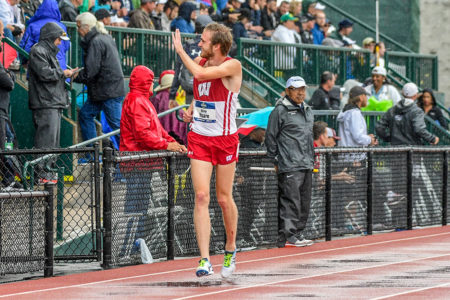
ON A SURE-TO-BE HOT midsummer Saturday afternoon 8 men will stand above their blocks, steeling their resolve and visualizing a race they have long prepared for. It will be 4:45 Central Time on July 27 when America’s best quartermilers line up in Drake Stadium to determine who will earn the right to wear the Team USA colors at the World Championships in Doha. Only 3 of them will succeed—and for a few others, there will be the consolation spot of a relay berth and a strong chance at a medal in that event.
But who will it be? From this April vantage point, a couple would seem to be the strongest of bets: Fred Kerley, the No. 1 World Ranker last year and Michael Norman, last year’s list-leader and the fastest again so far this time round. After that, the competition will be very spirited. Says former NCAA champ Vernon Norwood, “There are so many guys. And you know, there’s always some newcomer who comes out of nowhere. It’s very hard to predict because you never know who’s feeling like what and who’s going to smoke on that day.”
The timing of the meet may also play a big factor. Says 1-lap guru John Smith, Olympian and coach of Olympians, “I’ve had to read the [2019] schedule over and over and over again because I’m used to a certain rhythm. I have to look at it, ‘Hold on, don’t get too excited about what goes on early season.’ Even Mt. SAC. We still have 3 months before Nationals. That’s a whole ’nother training cycle.” Keeping that in mind, any absence from the competitive wars at this point in the year means nothing.
A Look At The Pros
Fred Kerley
The reigning world No. 1, Kerley will be 24 by the time of the USATF Championships. He’s hungry to win everything after a breakout ’17 season that took him to London undefeated—and too tired to place higher than 7th. Last year he put himself into 44.33 shape prior to Nationals but then sustained a hamstring injury. “I am highly motivated,” he tells us. He and coach Alleyne Francique have taken steps to ensure that he is fresh throughout the season. His first ‘19 race will be his latest start ever (a stunning 5 months later than his ‘17 collegiate campaign). He opens up on April 27 with a 200—one of his prime goals is to speed up his 200 best so he can more comfortably go out hard in a 400.
Norman says of Kerley, “Everybody knows through the years what he’s done. He has great potential. Last year was his first year running pro, so once he figures out that pro life and what it takes to run what he ran in college, he’ll be just as competitive.”
Michael Norman
Now in his first full season of pro running, the 21-year-old USC student stunned the world with his 43.45 opener. Says coach Quincy Watts of Norman and training mate Rai Benjamin (who ran 44.31): “Those times that they ran today, those aren’t those guys’ goals.”
Says Norman, “We’re not worried about peaking too early or anything. We’re just trusting the process and doing what they [his USC-based coaching team] ask.” With his ease at running unbelievable times, it’s hard not to say that Norman may have the biggest upside of any potential runner in the USATF final. One can almost picture Olympic gold medalist Jeremy Wariner shaking his head last weekend as he tweeted out, “He will run 42.”
Paul Dedewo
The CCNY grad was one of the big revelations of the ’18 season. He was not on anybody’s radar as a Bronx high schooler with a best of 51.05. As a collegian, he hit only 48.15. His best finish at the Div. III nationals was 8th in ’11. Hardly the stuff of future pro contracts. Dedewo persevered, however. In ‘15, he won the USATF Club crown in 45.41. Since then he has steadily improved. Last season he broke 45 some 9 times. His 44.64 took 2nd at USATF. Then he sprinted a PR 44.48 to win the World Cup and improved to 44.43 for 2nd behind Abdalelah Haroun at the London DL. So now the guy who didn’t break 50 in high school is ranked No. 3 in the world.
Asked what made the difference last year, the 6-1/160 Dedewo says, “I’m healthy, that’s the No. 1 thing.” He will be 28 by the time of USATF. Coached by Kevin Tyler at Phoenix-based ALTIS since ’16, Dedewo says, “I know I’m capable of running 43-seconds.”
“He has really come on strong as an older guy,” notes Kerley, who trained alongside him at ALTIS awhile in ’18. “He’s just patient with it.”

Gil Roberts
One of the older contenders, Roberts is now 30, but he’s not long past the form that saw him run a PR 44.22 and rank No. 6 globally in ‘17. The former Texas Tech star only raced through May last year before disappearing, ostensibly injured. He has been a key leg on U.S. 4 x 400 squads, with a 4×4 gold in ’16 and a silver at Worlds the following year. With no racing this season so far—and no response from his management and nothing much on social media, we can’t even be sure that Roberts hasn’t been abducted by aliens. But if he’s healthy and training, he could be a threat.
LaShawn Merritt
The grand old man of the event, Merritt will be 33 when the gun goes off in Iowa. The ’08 Olympic gold medalist also won world titles in ’09 and ’13. He has also run on 7 gold medal relays, so there’s no question he could factor if he’s in the shape of years past. However, the super-vet has not raced a 400 since the semis of the ’17 Worlds. Last season, he ran a decent selection of early-season 200s topped by a 20.48. “I plan on being in shape and healthy throughout the year,” he said prior to his final race. Then plantar fasciitis struck. At this point, with no subsequent competition it’s unclear if he’s injured, recovering or even retired. But one thing’s for sure. If Merritt is still in the game, his competitors still consider him a possible contender. Says Kerley, “LaShawn Merritt is LaShawn Merritt. He knows when to go at any given time.”

Nathan Strother
Now 23, Nathan Strother was one of the big collegiate finds of ’18. Running for Tennessee, the 6-1/145 Georgia native stunned with a 44.34 to finish as runner-up behind Nathon Allen’s 44.28 at the SEC meet. Then he missed the finals at the NCAA after an off-form 5th in his semi. He recovered well to finish 4th at USATF in 44.89, then acquitted himself notably in his first pro exposure in Europe, placing 2nd to Fred Kerley at the Diamond League final in 44.93.
Strother is one of the few Americans who took on the European indoor tour this winter, going undefeated with a best of 46.21. A perfect score gave him the 400 win in the World Indoor Tour standings, worth a cool $20K and a wild card berth in next year’s World Indoor Championships. His only outdoor appearance so far outdoors has been a relay leg in South Carolina. No word on whether he still wears his lucky Rudolph The Red-Nosed Reindeer socks in big meets.
Michael Cherry
LSU alum Cherry, now 24, was on the ’17 silver medal 4×4 at Worlds and ran 44.66 that season The next year he won silver in the World Indoor 400. He has ranked among the top U.S. racers for the last three years, even though he was troubled by an Achilles injury outdoors in ‘18. “I had it the whole time through,” he says. Now he’s healthy, training with legendary coach Smith, and turned a lap in 45.36 in his first ’19 race at Mt. SAC. A tall 1-lapper at 6-4 (1.93) he says he has no time goals for ’19: “I want to win. The time doesn’t matter, as long as you win. My goal for this season is basically just to make the team and end up on the podium. Whatever it takes, that’s what I’m going to do. I’m in love with the process and I’m trusting everything that he’s doing right now.”
Says Smith, “I can just run him and run him and run him, and the more I run him, the more he likes it. But what I do at the same time is I have to make sure that he doesn’t leave his effort in practice… He has a resting heart rate of about 42 beats per second. It’s off the charts. And he can take work. He’s fast but there’s an element of learning how to sprint.”
Vernon Norwood
A 4-time U.S. ranker, Norwood, now 27, has run 45.29 so far this season. His PR of 44.44 dates back to ’15, when he blasted that unlooked-for time in his season opener. He won the NCAA that year for LSU and finished 3rd at USATF, later running on the gold medal 4×4 at Worlds. Since then he’s had a bad luck streak at Nationals, not making the finals in three attempts for various reasons. This season he’s gunning to reverse that trend, saying, “I’ll have to compete my hardest to make the World Championships team. You’ve got to get out hard and be in position at 300 and then be able to go. Most of us, we’re all kind of similar runners. It’s just going to come down to getting through the rounds. Whoever gets to the final has a great shot of making the team.”
Tony McQuay
Another veteran to watch, McQuay is 29 now. The ’12 NCAA champ for Florida, he has U.S. Ranked 7 times, setting his PR of 44.24 in the semis of the ’16 Olympic Trials. In 2017, McQuay finished 5th at the USATF meet in 44.51. He was reportedly injured in ‘18. Now coached by Lance Brauman at Pure Athletics alongside Josephus Lyles at the National Training Center in Florida, all indications are that the former Gator is healthy and in good form, with some solid relay legs and a solid 200 (20.49w).
Rai Benjamin
The 400/400H double is impossible, so barring some strange development we won’t be seeing the hurdle standout in the flat 400. Says Coach Watts, “We want to have fun with some of the other events in terms of just being able to do those events well. And I think doing other events well will help his primary event. So the 400 and 200, he’ll be able to dabble in those events a little bit but he is definitely pointing to the World Championships with his primary event being the 400 hurdles.”
Recent relay practice holds that one must be in the 400 final to earn consideration, but Orin Richburg and his baton staff could do a lot worse than consider Benjamin for a leg in the 4 x 400. Last year he ran a 43.6 on USC’s Collegiate Record.
How About The Collegians?
Kerley coach Francique, who produced more than his share of NCAA 400 stars while at Texas A&M, thinks the college crowd will have a tougher time than usual making a dent at the selection meet, explaining, “They’re trying to get ready for June and the NCAA Championships. It depends on how they train. Normally they run again in 2–3 weeks time. This is going to be new to them, because now they have to run all the way through July. It’s going to be interesting to see if they can hold it.” Says Norwood, “The professionals will have an advantage because we’ll be more fresh. We’re not running week after week.”
Tyrell Richard
The South Carolina State find put himself into the conversation by winning the NCAA Indoor in 44.82 and following up with an outdoor opener of 44.81. He says it’s all the result of him becoming serious about the sport over the last school year. Last season, before he got serious, he ran a PR 44.70 in the semis at the NCAAs in Eugene. Now he’s taking aim at bigger targets, saying, “I’m never satisfied with not coming in first.” He has also revamped his race strategy by learning to go out faster, revealing, “Last year I would usually get out fairly easily and base the last 110m off my foot speed. But I see how I had to change so that I can become even better.”
Quincy Hall
In the same choose-an-event boat as Benjamin is the NCAA’s fastest flat runner on the year, 44.53 performer Hall. Unless something strange happens, we’ll expect to see South Carolina’s star running over the barriers—where his hopes seem better—in Des Moines.
Trevor Stewart
Not a big name last year as a frosh at North Carolina A&T, after running 46.44 as a prep in ’16. Says Aggie coach Duane Ross, himself ‘99 World Champs bronze medalist in the 110 highs, “You could tell he was a kid who hadn’t lifted any weights. He was pretty much new to this, just running on pure talent.” Stewart sat out in ’17, then as a frosh ran 45.28, finishing his season in the NCAA semis. “He wasn’t really competing last year,” says Ross. “He was going out and just running what he thought was his race. He ran so conservative like he was afraid to hurt or compete, you know, like a champion.”
Ross adds, “But he could come out and turn it on anytime he wants. He runs these crazy times in practice sometimes and he just messes up my workout. ‘What are you doing?’ I’m just looking at him not breathing hard, and he’s like, ‘Hey coach, it’s all good.’” This year’s Stewart, now 21, is different. “He’s on a mission himself,” says Ross. “He’s actually set the bar. The kid is saying he wants to run 43 seconds this year. He’s on his way, man.”
Kahmari Montgomery
The Houston senior is the defending USATF champion, winning last year in a PR 44.58, a performance impressive despite it being a non-championship year. It came after his disappointing 7th in the NCAA final, a race he called “a learning experience.” Over the winter, the 21-year-old put together a solid indoor campaign for the Cougars, winning the American conference in 45.04 and taking 2nd at NCAAs in 45.03.
Montgomery also has solid stick experience, running on the ‘16 World Junior gold team and this year’s NCAA Indoor champions. “As long as I put my heart and my mind to it, there’s nothing really that I can’t do,” he says. “I have more in me.” Looks like it. We’ve only seen his outdoor opener, an early-April 45.96 at home, but that’s more than a second faster than his opener last year at the same meet.
Wil London
The Baylor senior is way ahead of the experience curve for a 21-year-old. He ran on the ’16 World Junior 4×4 gold medalists after winning the individual silver. A year later, he qualified for the Worlds with a 44.47 PR run—out of lane 1, no less—for 3rd at USATF. At the WC he led off the relay squad with a solid 44.8 to win silver. That experience has shaped his outlook for the future: “It came from being confident, talking to coach [Clyde] Hart. He said just go ahead and do what I can do. I’ve run against the best in the world and I’ve applied that mentality to the NCAAs.”
Yet his junior campaign was not what he had hoped for; he hit a best of 44.73 and finished 8th at NCAAs and 7th at USATF. “It was one of those years where I was going through the motions after coming off a big year,” he explains. “I just wasn’t used to having a season like I did the year before. I went through little injuries in the indoor season, got healthy a little bit at the beginning of outdoor, but then it kind of bothered me back at the end. I made the right decision to not go to USAs so I could just get healthy for this year.”
This season he opened outdoors at the Johnson Invitational, winning handily in 44.93. “It was my fastest opener ever,” he points out. “I think I’m ready to get on with the season.” As for USATF, he says, “I’ll approach it the same way I do any other race: just be myself, worry about my own lane and just execute my race. I mean, that’s all I can do. I know these guys are running great, so just whoever I run against, I’ve got to apply pressure to get it done.”
Some Parting Thoughts
Others to watch: Josephus Lyles, still only 20, ran a best of 45.09 last year and made the USATF final. Mylik Kerley, 22, ran his best time of 44.85 in ’17. Obi Igbokwe, now at Houston, has a best of 44.94 from last year and ran on the winning NCAA Indoor 4×4. Mar’yea Harris of Iowa also has run 44.94. Last season he placed 4th in the NCAA at 45.00.
“The event is definitely peaking again,” says Watts. “What you’re seeing now with all the great coaching and the young athletes coming up, I think you’re looking at the result of a tremendous push over the last 6–7 years to make sure that event area is shining again. I think with the talent of Fred Kerley and Michael [Norman] and all the other young talent that’s coming up, the U.S. is definitely in good hands. But we have to be mindful. The rest of the world is catching up as well. As we’re making a resurgence, we have to make sure that we keep our eye on what’s behind us. And, with Wayde van Niekerk, what’s in front of us.”
Indeed, given that the rest of the world has been running the event very well as of late, making the U.S. team is certainly no assurance of a podium finish in Doha. Norman, for one, is stoked about the current state of the 400 internationally. “OK, so this is a very deep field, a very deep field, and I love it because I love competition and challenges,” he says. “The first name that comes to mind in the 400 specifically is, of course, Wayde van Niekerk. He’s kind of up in the air right now, you don’t know how he’s going to bounce back from his ACL. But if he doesn’t run extremely fast this year, he will definitely run extremely fast by 2020. He just has an easy year to freshen back up.
“Second, I would say Akeem Bloomfield [the 21-year-old Jamaican who finished as NCAA runner-up for Auburn last year in 43.94]. We ran in college together both our years. Very great talent, very fast, he has a lot of potential and I think he’s going to be one of the biggest competitors for the next, I don’t even know how many years, as long as he runs.
“Also you have Isaac Makwala, he’s going to be very fast. I don’t know how much longer he’s going to continue to run because he’s in his 30s now. And then Steven Gardiner, definitely, from the Bahamas. He’s also a great competitor, very tall, lean. If he just stays healthy throughout the year I think he could be a huge threat to the 400.”
Indeed, the Doha 400 will be a race for the ages. The hard part for U.S. fans will be dealing with the suspense—even a third of the way into the calendar year—of waiting so long before we find out who we’re sending.






